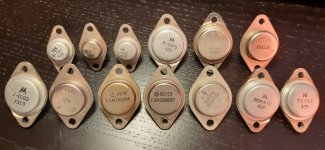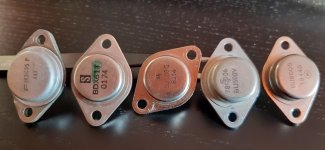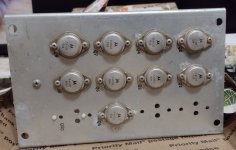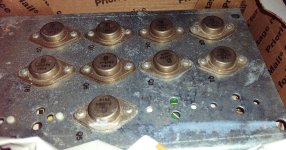G'day mates,
from a recently acquired shoebox full of vintage transistors, there are a few (house-numbered) types I'm not able to (fully) identify - I would appreciate any info you may have on these:
TO-66
TO-3
The ones in the second picture I have the base data for, but would like to find out what their suffixes mean:
Please note I don't really care if these can actually be used for anything worthwhile - I know that at least some of them are horizontal deflection / output transistors, so pretty much useless. But I would still like to find out some more information about them, just to satisfy my curiosity. 😊
Thanks a million!
from a recently acquired shoebox full of vintage transistors, there are a few (house-numbered) types I'm not able to (fully) identify - I would appreciate any info you may have on these:
TO-66
- 6-140, NPN, going by an otherwise unrelated google hit, 274 is the MIL MFG code of RCA (the case style seems to support that); going by the case style alone, 185 could be Motorola
- 6-5909, PNP, Motorola (?)
TO-3
- 6-5675, NPN Darlington, Motorola
- 6-6937, NPN, MIL MFG code 980 (?)
- 65826, NPN, RCA, found one reference of this one being used in Applied Digital Data Systems' CRT display terminals Consul 520, 580 and MRD 380
- 7-4503, NPN, Motorola / RCA
- ESM2668BP, NPN, Sescosem / Thomson, I have the base data for ESM2668, but would like to find out what the BP suffix stands for, if anything
- NCR8-05, NPN, Motorola, this may be a lucky coincidence, but are these just house-numbered BD130 as suggested by the Siemens part...?
- TE432, PNP Darlington, Motorola
The ones in the second picture I have the base data for, but would like to find out what their suffixes mean:
- 2N3055 P, Fairchild, what does the P stand for?
- BDX61T, S (?), what does the T stand for?
- BU208G, Motorola, I know that G on the more recent onsemi parts indicates they're lead-free, but did Motorola use that convention in 1982 already...?
- BU500V, Texas Instruments, what does the V stand for?
- BU800S, Motorola, what does the S stand for?
Please note I don't really care if these can actually be used for anything worthwhile - I know that at least some of them are horizontal deflection / output transistors, so pretty much useless. But I would still like to find out some more information about them, just to satisfy my curiosity. 😊
Thanks a million!
Attachments
It looks like a video output device from a CRT screen. There is a compliment available.
https://alltransistors.com/transistor.php?transistor=27059
https://alltransistors.com/transistor.php?transistor=27059
Sorry, I should have been clearer - in this case I am only trying to find out more info about the manufacturer, JPS. BF469-72 as such are well-known parts. Thanks!
Probably made in Europe way before they dislocated all semiconductor industry to China. Good luck finding that factory. They're dead as a Dodo.
Jet Propulsion Systems... well, weirder things happened, I guess. 😉
Checking on eBay, I found a few more JPS-branded transistors (although the logo is not identical), but no clue as to the manufacturer, not even when searching for those specific part nos.
I expect this one will also stay a mystery, just like those old metal cans in my original post...
Checking on eBay, I found a few more JPS-branded transistors (although the logo is not identical), but no clue as to the manufacturer, not even when searching for those specific part nos.
I expect this one will also stay a mystery, just like those old metal cans in my original post...
Attachments
Most likely what you found on EBay are fakes meant to fool someone that needs the transistor. They do that a lot. It’s a crap shoot if it will actually work in the place of a real one.
Fair Radio Sales used to offer a "heat sink with 6 pc. 2N3055 or equiv. house Nr. transistors" There were various TO-3 transistors used, and one of them was the 7-4503. That number's on various manufacturers' parts. Also, the Power Physics Nr. 3700161 is the same. I forget whose logo the "S" is.
Some of the heat sinks had 9 transistors on them, slightly different heatsink. This was not advertised but I received a few of those.
Some of the heat sinks had 9 transistors on them, slightly different heatsink. This was not advertised but I received a few of those.
Attachments
I hope you're joking.That's a PNP version.
- 2N3055 P, Fairchild, what does the P stand for?
The PNP compliment to the 2N3055 would be the 2N2955.
It was pretty common in the 70s and 80s that companies would take a generic device and put their own part number on the package. Motorola was one of them. For example an MC14093 was the same IC as the generic 4093 available from many manufacturers. Similarly, many parts in HP instruments had HP part numbers even though they were generic parts. I wonder if that's what's going on with these devices.
Tom
It was pretty common in the 70s and 80s that companies would take a generic device and put their own part number on the package. Motorola was one of them. For example an MC14093 was the same IC as the generic 4093 available from many manufacturers. Similarly, many parts in HP instruments had HP part numbers even though they were generic parts. I wonder if that's what's going on with these devices.
Tom
It is strangely interesting how many transistors of the past are hard to identify 😕
I wonder if there will ever be a full list & spec. of the Motorola SJ series ???
I wonder if there will ever be a full list & spec. of the Motorola SJ series ???
You got me excited there for a minute - had I missed that when initially checking those parts for basic functionality (there were hundreds of various TO-3 transistors in that shoebox)...?That's a PNP version.
- 2N3055 P, Fairchild, what does the P stand for?
But no...
Attachments
They’re called “Je ne sais quoi” transistors. I have lots of them too - many with only word of mouth generic descriptions - ie, “Like 2N3772”.It is strangely interesting how many transistors of the past are hard to identify 😕
I wonder if there will ever be a full list & spec. of the Motorola SJ series ???
There will never be any listing of what the SJ types are, other than what cross references there are in old service manuals. Even then a 2N may not be an exact match, but something that will work in the circuit. The SJ designation was used for something that they already made, and was tested to a custom spec or had other screening. That information was treated as trade secret and protected by law. Nobody from either company would ever officially say what it is, even for something totally obsolete and no longer being used. Peavey left enough information in their service docs to figure a lot of them out because their old alternate 7 digit type numbers had a KEY. They published the key.
Going back in time, regarding the BGW 750 power amp. a 2N3773 appeared to be a suitable replacement for the SJ original
BUT, the (future to be realized) SOA was not up to the task = BANG !
( it appears that BGW were using the MJ15003/4 series devices before retail consumer availability + gain matching )
BUT, the (future to be realized) SOA was not up to the task = BANG !
( it appears that BGW were using the MJ15003/4 series devices before retail consumer availability + gain matching )
Last edited:
The SJ original was a screened 2N3773. The SOA is fine. But breakdown voltage above 160V could not be guaranteed and still isn’t. Modern ones will test ok to 200V, as will the MJ15003. But the MJ15024 is better in every way. It just wasn‘t invented when the 750 came out.
RCA’s 2N6259 was the preferred type back then as it was guaranteed to be good to 170V and SOA was higher than 3773. But screened 2N3773s were easier to get, even by the big OEMs. Totally forget consumers or most service shops getting them. I found 2N6259’s far easier to get on the surplus market after MJ15024’s became mainstream and they’d been long discontinued - than they ever were during the decade that they were actively made and used.
RCA’s 2N6259 was the preferred type back then as it was guaranteed to be good to 170V and SOA was higher than 3773. But screened 2N3773s were easier to get, even by the big OEMs. Totally forget consumers or most service shops getting them. I found 2N6259’s far easier to get on the surplus market after MJ15024’s became mainstream and they’d been long discontinued - than they ever were during the decade that they were actively made and used.
- Home
- Design & Build
- Parts
- Please help identify vintage transistors







